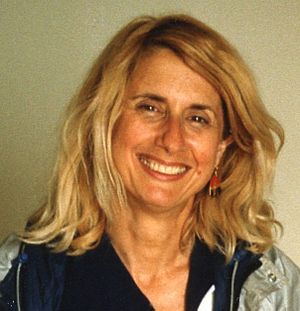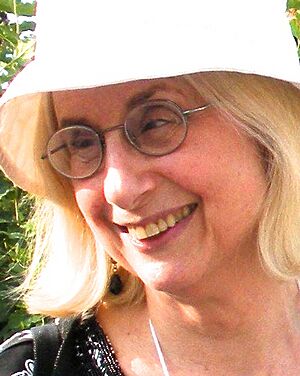Grace Wahba facts for kids
Quick facts for kids
Grace Wahba
|
|
|---|---|

Wahba in 1986
|
|
| Born | August 3, 1934 |
| Nationality | American |
| Alma mater | Stanford University University of Maryland, College Park Cornell University |
| Known for | generalized cross validation, smoothing splines |
| Scientific career | |
| Fields | Mathematics, statistics, machine learning |
| Institutions | University of Wisconsin–Madison |
| Thesis | Cross Spectral Distribution Theory for Mixed Spectra and Estimation of Prediction Filter Coefficients |
| Doctoral advisor | Emanuel Parzen |
| Doctoral students |
|
Grace Goldsmith Wahba, born on August 3, 1934, is an American statistician. She was a professor at the University of Wisconsin–Madison. She is known for creating new ways to work with "noisy data." This means she found methods to make sense of information that isn't perfectly clear.
Her work helps in many areas. For example, it is used in machine learning, which is how computers learn. It also helps with predicting weather and understanding medical imaging.
Grace Wahba's Life Story
Grace Wahba was interested in science from a young age. When she was in junior high, she received a chemistry set. At that time, she also thought about becoming an engineer.
Wahba went to Cornell University for her first degree. In 1952, Cornell and Brown University were among the few top universities that accepted women. She received her bachelor's degree from Cornell in 1956. Later, she earned a master's degree from the University of Maryland, College Park in 1962.
She worked in different jobs for several years. Then, she earned her doctorate degree from Stanford University in 1966. In 1967, she moved to Madison. She wrote a book called Spline Models for Observational Data. She retired from the University of Wisconsin-Madison in August 2018.
Awards and Special Recognitions
Grace Wahba has received many important honors for her work. She was chosen to be part of the American Academy of Arts and Sciences in 1997. In 2000, she joined the National Academy of Sciences. These are groups that recognize top scientists.
She is also a member of several other important academic groups. These include the American Association for the Advancement of Science and the American Statistical Association.
She has received many special awards in the field of statistics:
- The International Prize in Statistics in 2025.
- The R. A. Fisher Lectureship in August 2014.
- The Gottfried E. Noether Senior Researcher Award in August 2009.
- The Committee of Presidents of Statistical Societies Elizabeth Scott Award in 1996.
- The first Emanuel and Carol Parzen Prize for Statistical Innovation in 1994.
She also received honorary Doctor of Science degrees. These are special degrees given to people who have achieved great things. She received one from the University of Chicago in 2007. Another was from The Ohio State University in 2022.
In 2021, the Institute of Mathematical Statistics created a new award and lecture series. It is named the IMS Grace Wahba Award and Lecture, in her honor.
See also
 In Spanish: Grace Wahba para niños
In Spanish: Grace Wahba para niños


